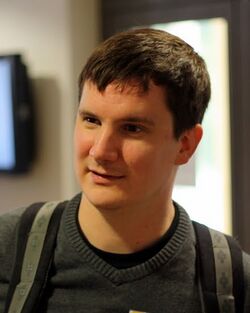Biography:Ryan Williams (computer scientist)
Ryan Williams | |
|---|---|
 Williams (November 2010) | |
| Born | 1979 (age 44–45) |
| Nationality | American |
| Alma mater | Cornell University Carnegie Mellon University |
| Scientific career | |
| Fields | Computational complexity theory, Algorithms |
| Institutions | Carnegie Mellon University IBM Almaden Research Center Stanford University |
| Doctoral advisor | Manuel Blum |
Richard Ryan Williams, known as Ryan Williams (born 1979), is an American theoretical computer scientist working in computational complexity theory and algorithms.
Education
Williams graduated from the Alabama School of Mathematics and Science before receiving his bachelor's degree in math and computer science from Cornell University in 2001[1] and his Ph.D in computer science in 2007 from Carnegie Mellon University under the supervision of Manuel Blum.[2] From 2010 to 2012, he was a member of the Theory Group of IBM Almaden Research Center. From Fall 2011 to Fall 2016, he was a professor at Stanford University. In January 2017, he joined the faculty at MIT.[3]
Research
Williams has been a member of the program committee for the Symposium on Theory of Computing in 2011 and various other conferences. He won the Ron V. Book best student paper award at the IEEE Conference on Computational Complexity in 2005 and 2007,[4] and at the best student paper award at the International Colloquium on Automata, Languages and Programming in 2004 from the European Association for Theoretical Computer Science.[5]
Williams’s result that the complexity class NEXP is not contained in ACC0 received the best paper award at the Conference on Computational Complexity in 2011.[6] Complexity theorist Scott Aaronson has called the result "one of the most spectacular of the decade".[7]
Williams has also worked on the computational complexity of k-anonymity.[8]
Personal life
Ryan is married to Virginia Vassilevska Williams, also a theoretical computer scientist.
Selected publications
- Meyerson, Adam; Williams, Ryan (2004), "On the complexity of optimal k-anonymity", Proceedings of the Twenty-Third ACM SIGMOD-SIGACT-SIGART Symposium on Principles of Database Systems (PODS '04), New York, NY, USA: ACM, pp. 223–228, doi:10.1145/1055558.1055591, ISBN 978-1581138580
- "Better Time-Space Lower Bounds for SAT and Related Problems", IEEE Conference on Computational Complexity (CCC), 2005, pp. 40–49
- "A New Algorithm for Optimal 2-Constraint Satisfaction and Its Implications", Theoretical Computer Science 348 (2–3): 357–365, 2005, doi:10.1016/j.tcs.2005.09.023
- "Time-Space Lower Bounds for Counting NP Solutions Modulo Integers", Computational Complexity 17 (2): 179–219, 2008, doi:10.1007/s00037-008-0248-y
- "Non-Uniform ACC Circuit Lower Bounds", IEEE Conference on Computational Complexity (CCC), 2011, pp. 115–125, doi:10.1109/CCC.2011.36, ISBN 978-1-4577-0179-5, http://www.stanford.edu/~rrwill/acc-lbs.pdf
References
- ↑ Curriculum vitae, http://people.csail.mit.edu/rrw/cv.pdf, retrieved 2017-12-02
- ↑ Ryan Williams at the Mathematics Genealogy Project
- ↑ "Ryan Williams | MIT CSAIL Theory of Computation" (in en). https://toc.csail.mit.edu/user/280.
- ↑ Proceedings of 20th Annual IEEE Conference on Computational Complexity (CCC'05) San Jose, CA June 11-June 15, ISBN:0-7695-2364-1, and Twenty-Second Annual IEEE Conference on Computational Complexity (CCC'07) San Diego, California, June 13-March 16, ISBN:0-7695-2780-9.
- ↑ "Best Student ICALP Paper". European Association for Theoretical Computer Science (EATCS). http://www.eatcs.org/index.php/best-student-icalp-paper.
- ↑ Program for CCC2011 at http://computationalcomplexity.org/
- ↑ Aaronson, Scott (November 8, 2010), "State of circuit lower bounds now slightly less humiliating", MIT Technology Review, http://www.scottaaronson.com/blog/?p=472.
- ↑ Meyerson & Williams (2004).
External links
- Ryan William’s homepage at MIT
- Ryan Williams publications indexed by Google Scholar
- Ryan Williams at DBLP Bibliography Server
 |

